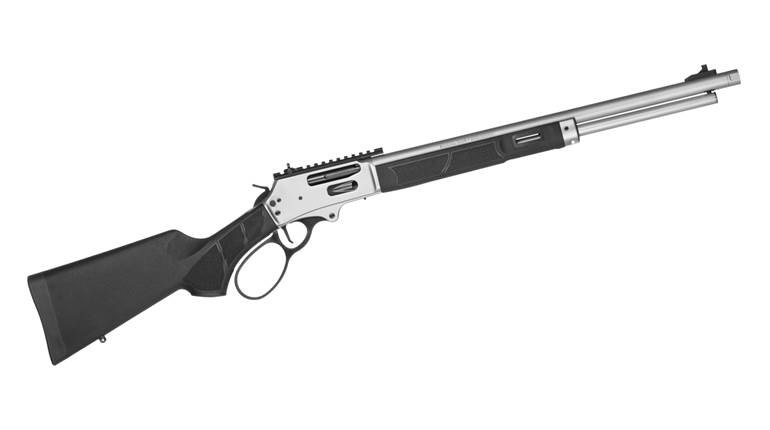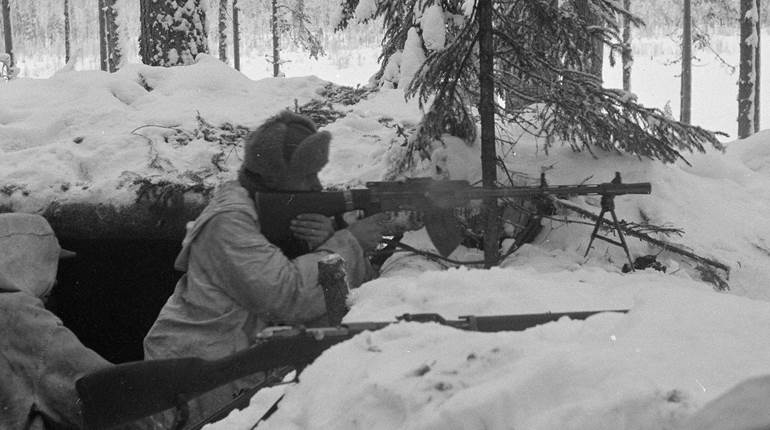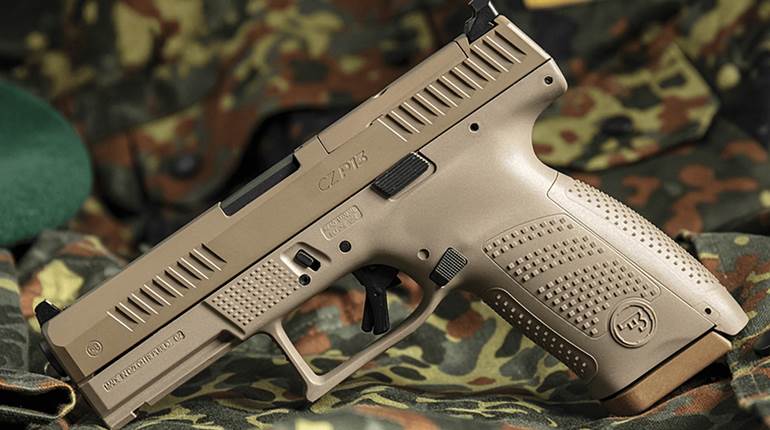
This article, "France's Great War Masterpiece", appeared originally in the October 2014 issue of American Rifleman. To subscribe to the magazine, visit the NRA membership page here and select American Rifleman as your member magazine.
Despite its impressive record, there are those today who insist on denigrating France’s Fusil Modéle 1886/93 “Lebel” insisting that by the time World War I began it was obsolete and out of date. True, it incorporated an early design or two that might have fallen out of fashion by 1914, but the fact remains that it proved to be a superb, effective arm, more than capable of holding its own against whatever the Boche could throw against it.

The story of the 1886/93 is as much a tale of the cartridge it fired as it is about the rifle itself, for it was the first general-issue military arm to employ a smokeless-powder cartridge. In fact, at the time of its adoption in 1886 it was considered more or less a “secret weapon” and its potential adversaries were avidly trying to find out anything they could about it.
In Armies of Europe, published in England in 1890 but written in the latter part of the 1880s, Prussian Feodor von Koppen penned of France’s new mystery gun:

“The magazine rifle of the French Infantry introduced in 1887, and called after its inventor, Colonel Lebel, director of the Normal School of Musketry at Chalons, is certainly equal to both the German models and the Austrian magazine rifles [1871/84 Mauser, 1886 Mannlicher] in shooting and general value. As regards the powder for its cartridge, the general composition of which remains a secret up until now, the inventor has claimed that its use will revolutionize infantry tactics.
According to French accounts, the powder is both smokeless and noiseless. If this were the case, no doubt it would produce changes in the mode of fighting and surprises would be greatly facilitated thereby. Last year, however, experiments made at the German Artillery School and the Manoeuvres with an almost identical powder, the results of which proved that the advantages of the French powder were greatly exaggerated. The report of the rifle is distinctly heard, and is little, if at all, less loud than the old powder. The smoke, it is true, is very much less but is still quite visible on a still day, its color being a transparent dull blue.”

One can read into this a degree of Teutonic envy—the new French cartridge was revolutionary and had considerable advantages over the black powder cartridge arms then being employed by the world’s powers. Simply put, its introduction would change the face of warfare.
Formative smokeless propellant had actually been around in the decades prior to the 1880s, most notably in early experiments with guncotton, a propellant invented in 1846 by Swiss chemist Christian Friedrich Schönbein, prepared by steeping cotton in a solution of sulfuric and nitric acid and then rinsing it with water and drying it.

Used most notably in the Austrian Lorenz rifle, the invention was tested by a number of countries, and it was determined to be too powerful and sensitive for use in small arms (though it did see limited employment blasting and in such things as torpedo warheads), on top of which it was prone to absorbing moisture. Later smokeless experiments by others were similarly found lacking to one degree or another.
It was particularly noteworthy then when, around 1884, French inventor Paul Marie Eugene Vielle, at the Laboratoire Central des Poudres et Salpetres in Paris came up with his revolutionary Poudre B. Originally called Poudre V, for “Vielle,” it was supposedly renamed (the “B” ostensibly substituted as a tribute to Minister of War Georges Ernest Jean-Marie Boulanger, though it has also been opined that “B” stood for blanc—white) to thwart German espionage efforts.

The flake-like nitrocellulose powder, gelatinized with ether and paraffin, was three times as powerful as blackpowder, produced considerably less smoke and fouling and was easy to manufacture—though early incarnations tended to break down and become unstable. Subsequently the stability of Poudre B was greatly improved.
Recognizing they were on to a good thing, the French immediately set in motion plans to develop a military cartridge and rifle to take advantage of this new wonder substance.

The Commission de Ármes a Répetition, comprised of Inspecteur de Manufacture Nationale d’Armes de Châtelleraut Col. Basil Gras (designer of France’s Fusil Mle 1874), Commandant de l’Ecole Normale de Tir Lt. Col. Nicholas Lebel, Col. Jules François Marie Bonnet, Directeur de la Pouderie du Bouchet, Col. Castan, Chef du Service de Armes Portatives se la Section Technique de l’Artillerie Col. De Tristan, Capt. Désaleux and Monsieur Vielle, was presented with the task of coming up with an appropriate package within a fairly short time frame.
Given the commission’s constraints, it worked efficiently and well by dividing tasks. Colonel Gras, with assistance, designed the rifle. It was a fascinating amalgamation of new and older designs. The magazine, for instance was adapted from that of the Fusil Mle 1878 (nicknamed “Kropatschek” as it was a variant of the Austro-Hungarian Model 1874 Kropatschek rifle) with which France had armed its marines.

This 11 mm, blackpowder, bolt-action repeater featured a tubular magazine running the length of the barrel, similar to that seen in Winchester lever-actions. Rounds were inserted into the magazine one at a time against a coil-spring-activated plunger. A lifter, hinged at the rear, dropped down when the bolt was closed to pick up a cartridge. When the bolt was opened and a case ejected the lifter snapped up, placing a round in position where it could be picked up and chambered by a forward thrust of the bolt.
The 1886’s bolt, while looking similar to that of the earlier Chassepot/Gras arrangement was considerably modified to handle the increased pressures of Poudre B. Where the Gras bolt locked mainly by means of a single bolster that rested against a shoulder on the action, the new arrangement, designed by Col. Bonnet, retained the separate bolt head design but featured sturdy, dual locking lugs. The scooped-out, knurled cocking piece was also held over from the Gras.

Possessed of a distinctive all-metal, slab-sided receiver and necessitating a two-piece stock, the fusil also incorporated a cut-off mechanism—a common feature on early repeaters, and one which lasted well into the 20th century. Involving a button, sited on the lower right of the action where it could easily then be manipulated by the shooter’s right-hand thumb, with the button in the rearward position the carrier/tray was allowed to pivot up and down to pick up rounds from the magazine. When the button was pushed forward the carrier was rendered immobile, permitting individual rounds to be inserted into the chamber, the remainder of the ammunition being held in reserve.
The sights of the Mle 1886 were well thought-out, though, like the rifle itself, and experienced some modification throughout the life of the arm. The rear ladder sight was initially graduated to 2,000 meters, although with the development of new rounds, this was ultimately increased to 2,400 meters. The ladder could be flipped forward 180 degrees to expose a 250-meter battle sight notch.

Early front sight blades incorporated a depression for a small dot of radium so the blade could be seen at night. This was later altered to a notch which would admit a pinpoint of light that the shooter could set a target upon. I have tried that with my own 1886 and, questionable as it sounds, under most circumstances it does work.
Measuring 51" overall, the new rifle weighed 9½ lbs. and had a 30½" barrel. The magazine held eight rounds and this, coupled with a round in the chamber and one in the carrier, gave the rifle a 10-shot capability—quite formidable for the period—that was only matched by the British Lee-Enfield during World War I.

Cartridge design was continuing apace with the rifle. Though the arm eventually was named for him, Lt. Col. Lebel’s contribution was actually a 232-gr., 8 mm flat-nose (to safely load cartridges nose-to-base without fear of accidental discharge) cupro-nickel-jacketed bullet. Dubbed, Cartouchè a Balle Ordinaire Modéle 1886, it was usually called Balle M for maillechort which means “nickel” in French. This projectile, coupled with a rimmed, tapered case necked-down and modified from that of the 11 mm Gras round by Captain Désaleux and backed by 35 grs. of Poudre B produced a round with a muzzle velocity of almost 2100 f.p.s., an astounding ballistic achievement for the time.
Production of the Fusil Mle 1886 continued apace and quantities were duly issued to troops where they were gladly received. Tests, field experience and parallel advances in other military arms subsequently indicated the ’86 platform and round could use a bit of tweaking. In 1893 the bolt head was improved with a rotating gas shield, minor receiver modifications and new firing pin assembly knob to allow gas to be safely vented in the event of a case failure.

As well, a stacking rod was added to the upper band to allow rifles to be piled without using a fixed bayonet. This modified arm was designated, appropriately enough, the Fusil d’Infanterie Modélè 1886 Modifié 1893 (or Mle 1886/93). This is the guise in which the Lebel will be most often encountered today. Unmodified ’86s are very rare. In 1902 a further change was instituted, that of eliminating the intermediary notch on the cocking piece, allowing the bolt to be manipulated more rapidly.
In 1898 Balle D, developed by Capt. Desaleux, was introduced into the service. This round incorporated a 198-gr. bronze, spitzer-type bullet which dramatically increased its effective range. It was the first boattail spitzer bullet to be adopted by any military.

The Model 1886 Lebel was fitted with a thin, 20½" cruciform-bladed Epéé bayonet with a metal (brass or nickel-silver) grip and hooked quillon, which was later dispensed with. The edged weapon produced invidious puncture wounds that were slow to heal and liable to infection. Nicknamed “Rosalie,” by the French, this bayonet was more appropriately called “the knitting needle” by the unappreciative Germans who were on the receiving end of Rosalie’s amour in World War I.

Like other military arms of the period, the Lebel was equipped with a number of accessories. Perhaps the most spectacular was the rifle grenade launching system, Tromblon Vivien-Bessières (or “VB”), which entered service in 1916, invented, as its name implies, by Messrs. Vivien and Bessieres was a considerable improvement over a couple of earlier designs. It involved a 50 mm cup (tromblon), which slid over the Lebel’s muzzle, held on by friction.
The grenade itself was cylindrical in shape with a circular channel running up the center. To fire it, the grenade was placed in the cup, the rifle placed with its butt on the ground and canted at an appropriate angle, and, using a live round, the gun was fired. The grenade was expelled by the force of the explosion, the bullet traveling through the central channel where it hit a metal striker, which in turn set off the detonator igniting the fuse.

Range was around 150 meters and fuse delay was five to eight seconds. It was extremely efficient—one of the best setups of its type used during the war. In fact, versions of the VB were adapted for use with the American M1903 Springfield and M1917 “Enfield.” It was possible for 16 grenadiers per company to launch upwards of 150 grenades per minute. Formidable!
There were other add-ons. Because of its superb accuracy and cartridge performance the Lebel was also used in the sniping role, and beginning in 1916 numbers were fitted with 3X scopes, affixed to the rifle by detachable mounts. Too, a special sheet-steel bolt cover (couvre culass) was supplied to protect the action from the debris of the trenches. It was easily attached to the bolt by the screw that joins the bolt to the bolt head. These were issued in some numbers but were not particularly popular with the Poilus and, consequently, they are not commonly encountered today.
Field-stripping the Lebel is not difficult at all. To free the bolt, first open the action and ensure the rifle is unloaded. Next, remove the large screw atop the stud joining the bolt body with the bolt head. The head may now be rotated 90 degrees to the right and the body withdrawn until the two part. They may now be cleared from the receiver. The complete trigger group can also be pulled from the gun for cleaning and servicing by merely removing a large, round-headed screw at the rear of the trigger guard and smaller screw on the lower left side of the receiver.

The introduction of the clip-fed, box-magazine 8 mm Berthier carbine in 1892 and its subsequent modification into musketoons and rifles meant the ’86 had a rival, and by the end of World War I a good number of Berthiers were seeing front-line usage. Still, this “new” arm never overtook the Lebel during the conflict.
Beginning in 1935 some 25,000 rifles in the original 8 mm were shortened in an attempt to make them conform to more modern dimensions. Most of these “86/93 R.35s,” as they were termed, were sent to units serving in North Africa. The ’86 continued as a principal French arm until 1938 when it was finally replaced by the 7.5x54 mm Fusil a Repetition Modéle 1936, though it would remain in inventory for a time after that.
Ultimately some 3,450,000 Mle 1886s were made between 1887 and 1916 at the French arms manufactories of St. Étienne, Tulle and Châtelleraut. As well as line infantry, over the rifle’s lifespan it was also issued to other French troops throughout the world and to units as disparate as the Foreign Legion, Chasseurs, Colonial troops and the Armée de Afrique, to mention only a few.
Though many experts vaunt the ’98 Mauser or Mark III Enfield as the preeminent infantry rifle of World War I, based upon its ruggedness, innovation, effectiveness and popularity with those to whom it was issued, I propose the Fusil de Infanterie Modéle 1886/93 is actually the true great rifle of the Great War.
The author offers sincere thanks to Patrick Hernandez and Christian Bories for their valued contributions during the preparation of this article. Since this article's publication, a cache of firearms discovered in Ethiopia and imported by Royal Tiger Imports has brought a number of surplus 1886/93 Lebel rifles into the United States. You can read the full story here.




































